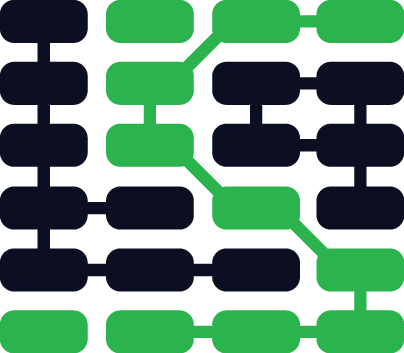Databases
A database is an abstraction on top of an operating system's file system to ease creating, reading, updating, and deleting persistent data.
Why are databases necessary?
At a high level web applications store data and present it to users in a useful way. For example, Google stores data about roads and provides directions to get from one location to another by driving through the Maps application. Driving directions are possible because the data is stored in a structured way.
Databases make structured storage reliable and fast. They also give you a mental framework for how the data should be saved and retrieved instead of having to figure out what to do with the data every time you build a new application.
Relational databases
The database storage abstraction most commonly used in Python web development is sets of relational tables. Alternative storage abstractions are explained in the NoSQL section of this guide.
Relational databases store all data in a series of tables. Interconnections between the tables are specified as foreign keys.
Databases storage implementations vary in complexity. SQLite, a database included with Python, creates a single file for all data per database. Other databases such as Oracle, PostgreSQL, and MySQL have more complicated persistence schemes while offering additional advanced features that are useful for web application data storage.
PostgreSQL and MySQL are two of the most common open source databases for storing Python web application data.
SQLite is a database that is stored in a single file on disk. SQLite is built into Python but is only built for access by a single connection at a time. Therefore is highly recommended to not run a production web application with SQLite.
PostgreSQL
PostgreSQL is the recommended relational database for working with Python web applications. PostgreSQL's feature set, active development and stability contribute to its usage as the backend for millions of applications live on the Web today.
PostgreSQL resources
-
This post on using PostgreSQL with Django or Flask is a great quickstart guide for either framework.
-
PostgreSQL Weekly is a weekly newsletter of PostgreSQL content from around the web.
-
Braintree wrote about their experiences scaling PostgreSQL. The post is an inside look at the evolution of Braintree's usage of the database.
-
This post estimates the costs of a PostgreSQL connection.
-
There is no such thing as total security but this IBM article covers hardening a PostgreSQL database.
-
Craig Kerstien's wrote a detailed post about understanding PostgreSQL performance.
-
Handling growth with Postgres provides 5 specific tips from Instagram's engineering team on how to scale the design of your PostgreSQL database.
MySQL
MySQL is another viable open source database backend option for Python web applications. MySQL has a slightly easier initial learning curve than PostgreSQL. The database is deployed in production at some of the highest trafficked sites such as Twitter, Facebook and many others major organizations. However, since the company focused on MySQL development, MySQL AB, was purchased by Sun Microsystems (which was in turn purchased by Oracle), there have been major defections away from the database by Wikipedia and Google. MySQL remains a viable database option but I always recommend new Python developers learn PostgreSQL if they do not already know MySQL.
MySQL resources
-
28 Beginner's Tutorials for Learning about MySQL Databases is a curated collection on various introductory MySQL topics.
-
This tutorial shows how to install MySQL on Ubuntu.
Connecting to a database with Python
To work with a relational database using Python, you need to use a code library. The most common libraries for relational databases are:
SQLite support is built into Python 2.7+ and therefore a separate library is not necessary. Simply "import sqlite3" to begin interfacing with the single file-based database.
Object-Relational Mapping
Object-relational mappers (ORMs) allow developers to access data from a backend by writing Python code instead of SQL queries. Each web application framework handles integrating ORMs differently.
Django provides an ORM with its core functionality. Flask leaves using an ORM up to an extension, such as Flask-SQLALchemy.
Developers can also use ORMs without a web framework, such as when creating a data analysis tool or a batch script without a user interface. Currently, the most widely used stand-alone ORM written for Python is SQLAlchemy.
Database third-party services
Numerous companies run scalable database servers as a hosted service. Depending on the provider, there can be several advantages to using a hosted database third-party service:
- automated backups and recovery
- tightened security configurations
- easy vertical scaling
Amazon Relational Database Service (RDS) provides pre-configured MySQL and PostgreSQL instances. The instances can be scaled to larger or smaller configurations based on storage and performance needs.
Google Cloud SQL is a service with managed, backed up, replicated, and auto-patched MySQL instances. Cloud SQL integrates with Google App Engine but can be used independently as well.
Database resources
-
DB-Engines ranks the most popular database management systems.
-
DB Weekly is a weekly roundup of general database articles and resources.
-
SQLAlchemy vs Other ORMs provides a detailed comparison of SQLAlchemy against alternatives.
-
A different view provides some perspective on the impedance mismatch between ORMs and traditional SQL queries.
-
Databases integration testing strategies covers a difficult topic that comes up on every real world project.
Databases learning checklist
Install PostgreSQL on your server. Assuming you went with Ubuntu run
sudo apt-get install postgresql.
Make sure the psycopg2 library is part of your application dependencies.
Configure your web application to connect to the PostgreSQL instance.
Create models in your ORM, either with Django's built-in ORM or SQLAlchemy with Flask.
Sync the ORM models with the PostgreSQL instance.
Start creating, reading, updating and deleting data in the database from your web application.
What's next to get your app running?
Databases
Need more detailed tutorials and walkthroughs than what is presented here? Sign up for an email alert when that content is created.
Matt Makai 先生在社区的协助下设计并编写了这个站点。如果你有Github账号,可以 follow他哦。想跟近这本书的最新状态去Github Star 这个项目吧!

